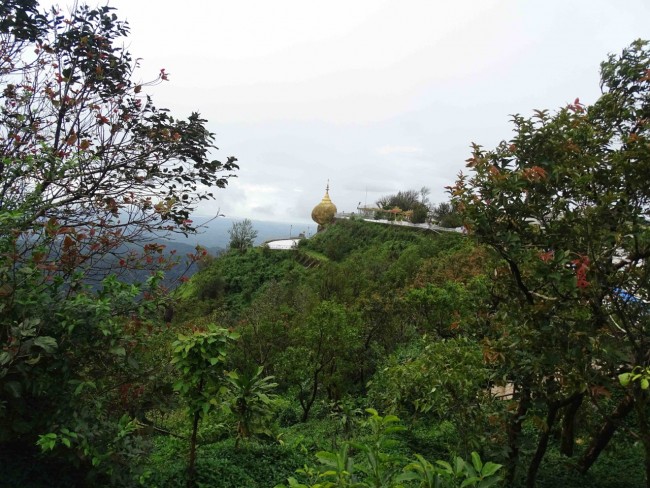The Pagoda Should Fall – But Doesn’t
When I saw the picture of the Golden Rock Pagoda, I was struck by the danger of choosing such a dangerous site as a place for a pagoda. It would never pass building standards in North America. But, then again, the Buddhists of Myanmar are not obliged to honour those standards. They answer to a higher power. The presence of a reliquary spire of a hair of Buddha embedded in the rock prevents the rock from toppling down the side of the mountain into the tropical forest below.
The rock is painted gold. It was beautiful in the day and is said to be even more beautiful at sun rise and sun set. There is even a small collection of hotels nearby to accommodate the non-Buddhists who want to visit the pagoda at those times.
The Buddhists built a small stupa measuring only 7.3 meters on top of the rock.
There is a short, narrow causeway connecting the main plaza with the Golden Rock Pagoda. Only men are allowed to cross the causeway. The Buddhist men who cross the causeway are able to press a small sheet of gold to the rock and gain merit by doing so.
The Golden Rock Pagoda is the third most sacred place in Myanmar. Tens of thousands of devotees come to visit the pagoda during the period of November to March. They – like me – can only see it from afar and a few are privileged – as I was – to be able to touch it if only for a moment.
The Journey is Not Easy
 It is not very easy to make the trip to see the Golden Rock Pagoda. I started out by taking an early morning bus from Yangon to Kyaikto. In my naiveté, I thought this was the site of the Golden Rock. Not true.
It is not very easy to make the trip to see the Golden Rock Pagoda. I started out by taking an early morning bus from Yangon to Kyaikto. In my naiveté, I thought this was the site of the Golden Rock. Not true.
Instead, a young man approached me and offered me a ride to his guesthouse. He told me I had to go to another town just to begin my trip to see the pagoda. I accepted his offer and got bounced around on a 10 km trip from Kyaikto to Kinpun. Kinpun is a bush town that has little to recommend it except that it is at the foot of the mountain and it offers accommodations for those on a pilgrimage – such as me. I took a room at the young man’s guest house for $12.
No sooner had I registered and paid, the young man led me down a dirt road to a shop. He told me I had to buy a plastic rain poncho for $1 Canadian. There was no arguing the point so I did as I was told – and within 20 minutes I was grateful for his guidance.
By that time, I had climbed off a platform onto a large, open-top bus (in much the same style one climbs off a platform to mount an elephant) to make the 11 km trip up the mountain. Soon after I boarded the bus, the rain started to pour. The poncho protected both my camera and me from the rain but not the cold. I was freezing on the 45-minute trip up the mountain. I was sure I had suffered from poor judgment by getting into the open top bus just as it was about to rain.
I was surprised and delighted when we got to the end of the bus ride at Yatetaung because the rain had stopped, the ground was dry, and the weather was warm. I was surprised because the tops of mountains in Canada are cold; it Myanmar they can be warm – even hot.
Alas, I had still not arrived at the Pagoda. I had only come to the end of the road suitable for the bus. From there I started a 45-minute trek on foot up the mountain. I passed half a dozen hotels and restaurants on the way and eventually reached the edge of the sacred ground. I knew it was sacred because there were signs telling visitors to take off their shoes and socks and leave them behind. Again, I did as I was told. From that point, I needed to continue walking up the mountain over tiled plazas and stairs to reach the grand plaza beside the Golden Rock Pagoda. As soon as I saw it I knew it was worth the time, cost, and effort to make the journey.
The rock and pagoda in reality looked exactly as they had on the travel posters: awe inspiring and yet quite simple. The pagoda looked like a little New Year’s hat on top of an over sized head. Now, at last, I knew I had arrived.
I took pictures from afar and nearby. I crossed the causeway and touched the rock. I walked through the rest of the sanctuary reserved for men only and saw other religious artifacts that all looked hand made. It looked as though all the artifacts were made with love by amateurs. And they all served their purposes admirably well.
Photo Credits
All photos by Jan Wall – All Rights Reserved






Please Share Your Thoughts - Leave A Comment!